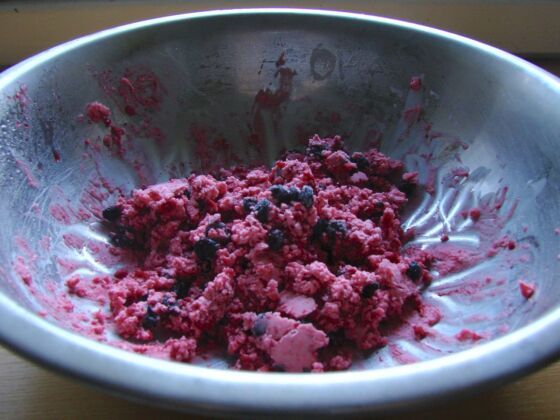Charity Blanchett vividly recalls childhood visits to Tuntutuliak, the Yupik village in Alaska where her mother grew up: The day-long berry picking excursions and hauling ten-gallon buckets out into the tundra to fill with salmon berries and lowbush cranberries. The Honey Bucket outdoor toilet and the lack of running water in some homes that she says at first felt like “culture shock.” But what really stands out in her mind are the days her mother and aunties would gather in the kitchen to prepare akutaq (pronounced a-goo-duk). Her mother would spread cardboard on the floor and settle in front of a huge stainless steel bowl, into which she would mix the ingredients for this uniquely Alaskan dish.

This Savory Alaskan Ice Cream Is Made With Berries, Fish, and Caribou
Akutaq is a frozen dessert invented by indigenous Alaskans. It was originally a way to provide nourishment on long hunting or whaling trips out in the cold, inhospitable tundra where there isn’t much nutritious food to keep hunters warm and energized. The name akutaq comes from the Yupik phrase meaning “mix them together.” The traditional recipe is a fatty, creamy mixture of moose or caribou meat and fat, white fish like pike or cod, or seal oil, along with blueberries, salmonberries or cranberries, and ice. There’s also a version called green agudak that incorporates dandelion greens.
A University of Alaska Fairbanks Alaska Native Knowledge Network blog post on akutaq explains how sometimes a short ceremony is conducted after the akutaq has been prepared: The person who mixed the ingredients will draw the shape of a cross, and then take one of each type of berry and a “pinch of the mixture” and throw it into the fire while repeating the phrase “Tamarpeci nerluci,” or in English, “All of you eat.”
“There are a lot of indigenous families up north in Alaska who still practice subsistence living, so they live off their land, hunting, fishing, and gathering,” Blanchett tells me. “So when you put meat in agudak, it just makes it a bit more hearty for when you’re out there in the elements.”
Blanchett is a Yupik Eskimo and African-American woman, and akutaq was a staple in her childhood in Wasilla. Modern versions of the dish combine the fish or caribou fat and meat with Crisco (or replace the animal fat entirely) — an ingredient Blanchett speculates might have been introduced to indigenous tribes by settlers and missionaries.
No matter how it became such an accessible ingredient, Crisco has become a beloved addition to akutaq. Blanchett says her mother made her version with Crisco, sugar, raisins, tart salmonberries, and potato flakes to make it extra fluffy.
Blanchett’s parents made sure she and her siblings were well acquainted with both sides of their heritage. Both of her parents are pastors, and she attended many church potlucks at the African Methodist Episcopal Zion Church where she was baptized. Her mother spoke Yupik to the kids and they also received Yupik names. Blanchett’s is Qalutaq, which means dipping spoon, or as she explains it, “you dip into the water, the water is given to everyone, and it grows and keeps giving.”
If Blanchett’s school friends tried akutaq, it was probably at her parents’ house. For birthday parties, her mother would whip up big batches of akutaq by hand — no motorized appliances needed — alongside Western ice cream and cake. The family embraced and celebrated the Yupik way of life — both in and out of the kitchen. Her father built a traditional maqii steam bath in the backyard for her mother, as well as a smoker, so that she could prepare dried and smoked fish according to tribal custom.
“We ate moose and caribou meat instead of ground beef and whale muktuk, and my mother ate frozen white fish or pike dipped in seal oil. It’s quite pungent,” says Blanchett. “It’s so interesting to me that Japanese food is elevated to this grandeur, but indigenous Alaskan food is very similar. [Yet] it doesn’t get the same clout as Japanese cuisine. And I think that’s [due to] to Western ideals and colonization.”
Blanchett is keenly aware that the culinary industry — from who decides which cookbooks to publish, to who is hired for prestigious chef positions, to what dishes make it onto a menu or food-focused television show — routinely excludes and shuts out women of color and rejects their ideas and ambitions in the food world. That’s why she started The Dipping Spoon Foundation (a nod to her Yupik name), which provides scholarship opportunities for Black and indigenous women to attend culinary school at the New Orleans Culinary and Hospitality Institute, or train to become a food stylist, recipe developer, or food photographer.
Most of all, Blanchett believes in the resilience of indigenous people and in their ability to be creative innovators and survivors who will hold tightly to their traditions, even if it means thriving outside the culinary establishment. And perhaps those characteristics are best epitomized by the invention and continued devotion to akutaq among Alaskan native peoples. It’s a dish that exemplifies the industrious ways indigenous people have learned to make ingredients stretch over long periods of time, transforming them into foods that are healthy and sustaining.
“Depending on where you live in Alaska, summer is really short, but you have to have a full freezer and fridge,” says Blanchett. “I truly believe that indigenous people are so strong because we have to be. It’s a matter of survival. We’re so gritty because we have to survive the elements.”